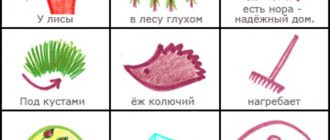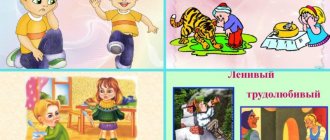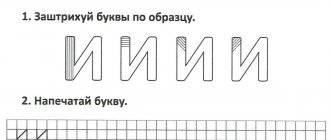Mnemonic tables for memorizing poetry
Mnemonic tables are especially effective when learning poems. Using supporting drawings to teach memorizing poems captivates children and turns the activity into a game.
Stages of working on a poem:
- The teacher reads the poem expressively.
- Informs that the child will learn this poem by heart.
- Then he reads the poem again using the mnemonic table.
- The teacher asks questions about the content of the poem, helping the child understand the main idea.
- The teacher finds out which words are incomprehensible to the child and explains their meaning in a form accessible to the child.
- The teacher reads each line of the poem separately. The child repeats it using a mnemonic table.
- The child recites a poem based on a mnemonic table.
A. Barto “Spring is coming” In the morning it was sunny and very warm. A wide lake flowed across the yard. It froze at noon, winter came again, The lake was covered with a crust of glass. I split the thin, ringing glass, and the wide lake began to flow again. Passers-by say: Spring is coming! -And this is me working, breaking the ice.
Our body Wash dishes - the finger hurts, Carrying water - the finger hurts, Writing a letter - the finger hurts, And the soup is ready - the finger is healthy.
Autumn Autumn, autumn is coming to us, What does autumn bring to us? Colored leaves, forest berries, vegetables for dinner, many clouds in the sky.
Forest. Trees Masha went out onto the porch (for children of the older group) Masha went out onto the porch: Here is a tree growing, Here is another growing, How beautiful! Mashenka began to count and counted exactly five. Count all these trees, children!
Willow (for children of the preparatory group) Near the river near the cliff The willow is crying, the willow is crying. Maybe she feels sorry for someone? Maybe she's hot in the sun? Maybe a playful wind pulled the willow by its pigtail? Maybe the willow is thirsty? Maybe we should go ask?
Vegetables We take vegetables in our hands...
We take the vegetables in our hands and put the vegetables on the table. Onion, carrot, zucchini, tomato, peas, onion.
The hostess The hostess came home from the market one day, The hostess brought home from the market: Potatoes, cabbage, carrots, peas, Parsley and beets, oh! Covered with a lid, in a stuffy pot Boiled, boiled in boiling water: Potatoes, cabbage, carrots, peas Parsley and beets, oh! And the vegetable soup turned out to be quite good! (Y. Tuvim)
Fruits We take fruits in our hands...
We take fruits in our hands and put them in a basket: Plum, peach, orange, pear, kiwi, tangerine.
Compote We will cook compote. We need a lot of fruits. Here. We will chop apples, we will chop pears. Squeeze out the lemon juice, add the drain and sand. We cook, we cook compote, Let's treat the honest people.
Sadchikova Irina Gennadievna teacher-speech therapist, Tolyatti
Lesson notes for kindergarten. Learning a poem using a mnemonic table
Abstract “Meeting in the literary drawing room” (learning a poem using a mnemonic table)
Author : Pestova Natalia Nikolaevna The abstract will be useful for preschool teachers. Goal: To strengthen children’s ability to use mnemonic tables when memorizing poems. Objectives: Developmental: • develop memory; • visual attention, • imaginative thinking, • coherent speech. Educational: • continue to teach children to listen carefully to a work of art; • answer questions from an adult; • ask questions yourself; • consolidate the ability to memorize a poem using mnemonic tables Educational: • continue to teach children to listen carefully to a work of art; • answer questions from an adult; • ask questions yourself; • consolidate the ability to memorize a poem using mnemonic tables. Educational: • cultivate interest in works of art; • learn to work in a team; • cultivate a desire to help those who are experiencing difficulties. Types of children's activities: • communicative; • educational; • artistic. Methodical techniques: • conversation-dialogue; • reading a poem; • telling a poem using mnemonics; • productive activity; • physical education session; • analysis, summing up. Handouts: • mnemonic tables (ready-made) • paper, felt-tip pens Contents of educational activities. -Guys! Look how many guests we have. You were great for greeting them, that is, you wished them health. -I again invite you to the literary drawing room. Let's tell our guests what we are doing in it? (we read fairy tales, learn poetry, talk about writers, artists, etc.)
- What is this?
(envelope)
- I wonder who this letter is to.
There is no address on the envelope, but there are some symbols. (d/s No. 23, symbols of children, rainbow)
- Can you decipher them?
(Yes. Kindergarten No. 23, to the children from the Rainbow group)
- Why do you think this envelope is for us?
(This is us. We go to d/s No. 23, to the Rainbow group)
- So we can open it?
- What is this? ( mnemotables)
- There are many tables, but little time.
What needs to be done to have time to decipher all the tables? (split into teams)
-How can we do this?
(counting table, 1-2-3, bracelets, etc.)
- Well done!
Let's then divide into teams. Please take a seat at your tables. - Take assignments. - Work, consult, help each other. —Which team is ready? - Who from your team will come out and decipher the task. - Well done! - Guys, there is still a table in the envelope. Let's decipher it too. - Look at it. Maybe someone can decipher it? Difficult? — What are your guesses: What is this poem about? — Would you like to hear this poem? This poem was written by the poet Raisa Adamovna Kudasheva. Raisa Adamovna has been writing poetry since childhood. She worked for many years as a school teacher and then as a librarian. Raisa Adamovna is the author of the poem “Yolka”, part of this poem is set to music. This is how the song “A Christmas tree was born in the forest” appeared. This song is known and loved by everyone - both adults and children. Raisa Adamovna wrote many more poems for children. We will meet one of them today. It’s called: “Now the silver winter has come...” (you can close your eyes and imagine what is happening in this poem)
Now the silver winter has come, Covering the clean field with white snow.
During the day everything goes skating with the children, and at night it crumbles into snowy lights. He paints a pattern in the windows with needle ice, And a fresh Christmas tree knocks on our yard! — Did you like this poem? Would you like to learn it? — You and I know how you can quickly learn any poem, even a complex one. (using a mnemonic table)
Let's remember: - What is it about?
(about winter)
- What kind of winter has come?
(Now the silvery winter has come)
- What did she do?
(The clear field was covered with white snow)
- What does winter do during the day?
(Everyone goes ice skating with the children during the day)
- What does she do at night?
(At night it crumbles into snowy lights
) - What does winter do in the windows?
(He writes a pattern in the windows with needle ice)
- What else does he do?
(And a fresh Christmas tree knocks on our yard)
- I’ll read this poem again, and you look at the table and repeat to yourself.
— Maybe someone wants to tell us this poem? -Guys! You and I know a lot of poems, we can memorize them easily and quickly. Do you think our guests would like to learn poetry just as quickly? Let's ask them! - Well. Let's teach. - You and I know the game when we encrypt words from a poem with symbols - “Encryptors” - What do we need for this? (sheet and markers)
- But before you start encoding, I want to wish you something.
I will pronounce the wish, and you do the massage. I wish that your head would think, I wish that your eyes would see everything, I wish that your ears would listen carefully, I wish that your mouth would speak beautifully, I wish that your hands would draw carefully, I wish to keep you healthy. -Well, let's get started. Listen carefully to the poem. It's called "Why does the bear sleep in winter?" Bear, bear! What happened to you? Why do you sleep in winter? Because snow and ice are not raspberries and not honey. (R. Orlov) - Who is this poem about? (about the bear
) - What do they ask him?
(Why do you sleep in winter?)
- Why does he sleep?
( Because snow and ice, not raspberries and not honey)
- Let's now encrypt this poem. — Did everyone succeed? Well done. - Who wants to recite a poem using their mnemonic table now? Maybe one of the guests would like to read this poem using your table? - Did you like it? - What did we do today? — What did you like most? — What was difficult? — If you liked everything and found it interesting, take a red flower; if you still need to work on something, take a green one; if you didn’t like anything, take a blue one. Our literary lounge is closing. See you.
We recommend watching:
Modern educational technology mnemonics in preschool educational institutions How to quickly learn New Year's poems with children Current homework: mnemonics and mnemonics tables Mnemonic tables for kindergarten “Properties of materials”
Similar articles:
Methods of conducting physical education classes in kindergarten
Morning exercises in the preparatory group in a playful way
Teasing games for children 5-6 years old
Dance festival in kindergarten for children 5-7 years old. Scenario
Outdoor games as a means of harmonious development of a child
Principles of operation of mnemonic tables
Note that to encode a poem, even the simplest image for a line or an entire quatrain is sufficient. It is not necessary to be a professional artist to depict the objects or actions described in the work. In a mnemonic table it is possible to schematically display the entire world around us: natural phenomena, events, signs of objects, actions of characters. The method of mnemonic tables has been developed in detail, with the necessary instructions, which does not cause difficulties in application.
The scope of the article does not imply an extended description of the methodology, so we will focus on its main principles. Work begins with the construction of a mnemonic square that corresponds to a specific word. For example, the poem “White Birch” by Sergei Yesenin is memorized. Using the word “birch,” the teacher suggests considering the symbolic designation of a tree. This should be a simple and accessible drawing for children that they can complete on their own. Then we do the same with other words, for example, “window”, “snow”, “branches”, etc. So children begin to gradually understand what the symbol of the word means.
At the beginning of training, colored mnemonic tables are offered, since color images quickly appear in children’s memory: snow is white, spruce branches are green, the sky is blue. Then, as specific skills in depicting objects are mastered, black and white symbols are used so as not to be distracted by their brightness.
Subsequent work on the poem involves a gradual transition from mnemonic squares to mnemonic tracks, which designate entire poetic phrases. This is how the poem is gradually memorized and reproduced using conventional symbols.
After mastering the necessary initial knowledge about symbols, children are led to actions with mnemonic tables. The number of cells in the table depends on the complexity and size of the text, as well as on the age of the students. Thus, the entire poem is recorded schematically.
Teachers note that as they learn, children are actively involved in creating their own scheme. After this, they reproduce the entire text from memory, using only a symbolic image.






